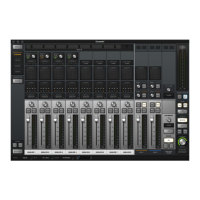Apollo Thunderbolt Software Manual Working With Apollo 21
Using Apollo as an Audio Interface
Apollo functions like other (non-DSP) audio interfaces when it is used without the
Console application, the Console Recall plug-in, or UAD plug-ins. Apollo’s Core Audio
(Mac) and ASIO (Windows) drivers enable it to be used for computer audio I/O routing
with any Core Audio-compliant or ASIO-compliant audio software, including DAWs, music
players (e.g., iTunes), system software alert sounds, and similar applications.
Accessing Apollo I/O via Core Audio and ASIO
Audio is routed to and from Apollo via its Core Audio / ASIO device drivers. The audio
software accesses Core Audio / ASIO interfaces directly via the audio settings/preference
panel in the audio software, or it uses the audio device set as the preference in the
operating system.
Windows ASIO and WDM settings
On Windows systems, ASIO and WDM are different subsystems that are configured
separately. ASIO system settings are configured in the Apollo Console Settings>Hardware
panel and within the DAW preferences. WDM system settings are configured in the
Sound control panel within Windows.
Note: When using Apollo for WDM system sound I/O, the sample rate of both
subsystems must be set the same rate to be heard in both subsystems. See
Windows WDM System Audio Operation Notes for related information.
Apollo I/O Driver Names
Each Apollo input and output has a channel number and name provided by the Apollo
drivers to Core Audio and ASIO. If an audio software application can access Core Audio/
ASIO devices directly, it may be possible to designate specific inputs and/or outputs
within the application.
All Apollo driver I/O numbers and names are listed in Driver I/O Tables. These values can
be used to reference specific Apollo inputs or outputs by number or name if allowed by
the application.

